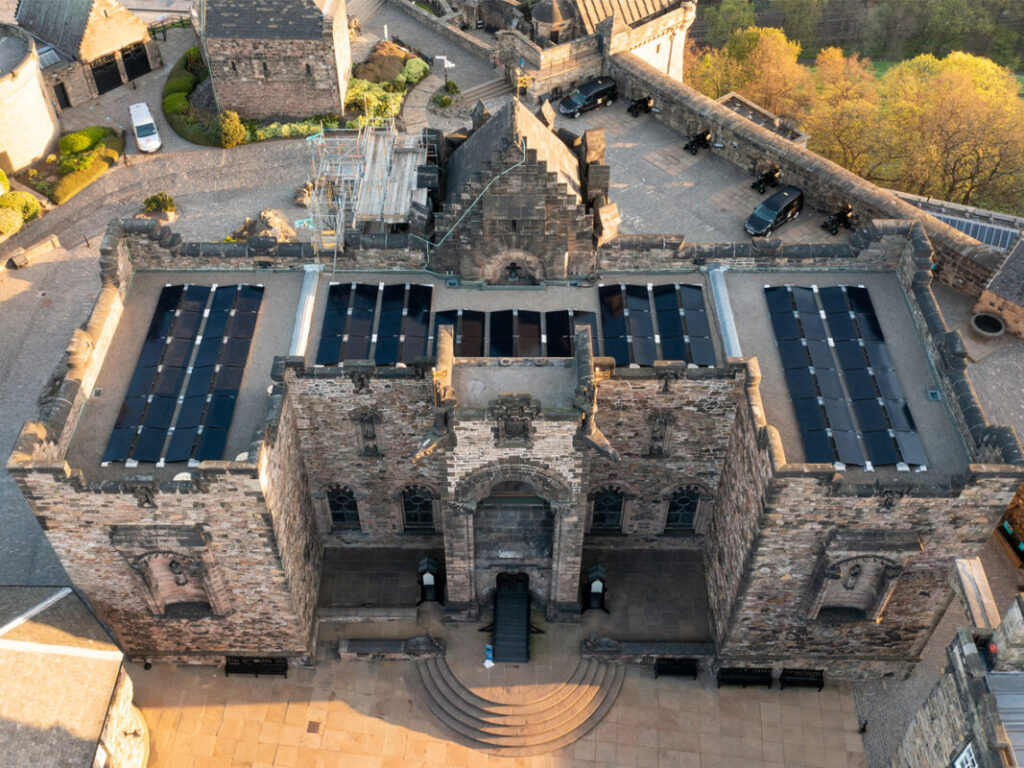Scottish government falling behind on rooftop solar, trade body says
 Small-scale solar installations in Scotland increased by 174% in 2023 – including installation on Edinburgh Castle (pictured). Image: Historic Environment Scotland.
Small-scale solar installations in Scotland increased by 174% in 2023 – including installation on Edinburgh Castle (pictured). Image: Historic Environment Scotland.
Solar Energy Scotland has raised concerns over the new energy efficiency standard for buildings put forward by the Scottish government.
Last week, the Scottish government opened a consultation on implementing rules inspired by the international Passivhaus standard. The original, or ‘Classic’ Passivhaus was devised when renewables were rare and expensive, so it certified that buildings have very high levels of insulation and air tightness, leading to low energy demand.
Passivhaus Classic has been superseded by ‘Plus’ and ‘Premium’ forms, which call for mandating the installation of renewable energy in domestic and non-domestic buildings, including solar thermal systems for producing hot water.
In early 2023, member of Scottish parliament Alex Rowley’s proposed Domestic Building Environmental Standards (Scotland) Bill gave rise to the plan to implement the Passivhaus standard. The consultation paper states: “There is increasing recognition and application of the standard, which contributes positively to overall energy and net zero objectives.”
However, the consultation is based on Passivhaus Classic, which Solar Energy Scotland says would be obsolete before it ever enters force. The move would also place Scotland well behind the EU, which mandated solar panels for all newbuild properties, with England expected to do the same.
Indeed, the consultation does not mention solar power at all.
Josh King, chair of Solar Energy Scotland and director of sustainable energy services company Gensource, said: “We welcome the Scottish government’s intentions to upgrade fabric and comfort standards and improve quality assurance for newbuild properties.
“However, we caution against using outdated energy calculations that undervalue on-site generation such as solar power, and the huge opportunities of battery energy storage and smart home energy management. We would encourage the Scottish government to align with the EU and the rest of the UK on rooftop solar.”
Scotland’s solar industry
According to Solar Energy Scotland, the Passivhaus consultation repeats the mistakes made with the New Build Heat Standard (NBHS): The Scottish government’s proposals only specify a standard for energy delivered, rather than produced, by buildings.
The NBHS prohibits burning fuel for heat, intended to lead to mass heat pump adoption; however, it does not mandate that rooftop solar power is installed alongside a heat pump. Preceding iteration of the regulations had led to the vast majority of new Scottish homes installing photovoltaic panels, driving down emissions and energy bills alike.
Last year, the government committed to boosting solar capacity across Scotland to 4-6GW by 2030—since then, the Labour government has shown a huge interest in the technology.
Scotland has been a contentious area for solar, with Scottish net zero minister Mairi McAllan announcing on 18 April that the Scottish government would not reach its 2030 emissions target.
This content was collected from the Internet. If you want to it, please contact grace solar management.